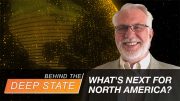
The launch of the James Webb Space Telescope from the European Space Agency’s (ESA’s) launch site in French Guiana on Christmas morning was breathtaking. A joint venture involving NASA, ESA, and the Canadian Space Agency (CSA), it was the culmination of decades of work and the investment of billions of dollars.
The irony of the launch on the day when Christians celebrated the birth of their Savior, Jesus Christ, was also breathtaking. But NASA and the media covering the launch missed the connection altogether.
Bill Nelson, NASA’s administrator exulted:
The James Webb Space Telescope represents the ambition that NASA and our partners maintain to propel us forward into the future.
The promise of Webb is not what we know we will discover; it’s what we don’t yet understand or can’t yet fathom about our universe….
It’s a time machine. It’s going to take us back to the very beginnings of the universe. We are going to discover incredible things we never imagined.
The telescope, riding on the Ariane 5 rocket, is headed nearly a million miles into space. Its destination is L2, the “second Lagrange Point,” which is described as “a wonderful accident of gravity and orbital mechanics … the perfect place to park the Webb telescope in space.” It’s one of six such known “accidents,” where gravity from the sun and the Earth will allow it to stay in a fixed position, requiring a minimal amount of energy to keep it stable for at least the next 10 years.
CBS News said the telescope “will attempt to capture starlight from the first galaxies to be born in the fiery crucible of the Big Bang.” It added:
The telescope is optimized to capture images of the first stars and galaxies to begin shining in the aftermath of the Big Bang, light that has been stretched into the infrared portion of the spectrum by the expansion of space itself over the past 13.8 billion years.
That light can’t be seen by the iconic Hubble, which Webb will eventually replace. Hubble was designed to study visible light wavelengths but even so, it has detected galaxies dating back to within a half billion years of the Big Bang.
Webb should be able to push several hundred million years beyond that, detecting light that began heading out when the universe was just 200 million years or so old. That’s the era when the cosmos first emerged from the hydrogen fog of birth and starlight began traveling freely through space.
The long hoped-for baby pictures of the universe are expected to shed revolutionary light on the formation and evolution of galaxies, the supermassive black holes that lurk at their hearts and the life cycles of stars, from birth to the titanic supernova blasts that cooked up most of the elements in the periodic table.
NASA itself described the mission:
- To search for light from the first stars and galaxies that formed in the Universe after the Big Bang;
- To study the formation and the evolution of galaxies;
- To understand the formation of stars and planetary systems;
- To study planetary systems and the origins of life.
Dr. Wernher von Braun, the chief architect for the Apollo Saturn V rocket for NASA, had a vastly different view of what the Webb telescope might find. In a letter he wrote to the California state Board of Education in 1972, he said:
In response to your inquiry about my personal views concerning the “Case for Design” as a viable scientific theory for the origin of the universe, life and man, I am pleased to make the following observations.
For me, the idea of creation is not conceivable without invoking the necessity of design. One cannot be exposed to the law and order of the universe without concluding that there must be design and purpose behind it all.
In the world around us, we can behold the obvious manifestations of an ordered, structured plan or design. We can see the will of the species to live and propagate.
And we are humbled by the powerful forces at work on a galactic scale, and the purposeful orderliness of nature that endows a tiny and ungainly seed with the ability to develop into a beautiful flower.
The better we understand the intricacies of the universe and all its harbors, the more reason we have found to marvel at the inherent design upon which it is based.
While the admission of a design for the universe ultimately raises the question of a Designer (a subject outside of science), the scientific method does not allow us to exclude data which lead to the conclusion that the universe, life and man are based on design.
To be forced to believe only one conclusion – that everything in the universe happened by chance – would violate the very objectivity of science itself.
Certainly there are those who argue that the universe evolved out of a random process, but what random process could produce the brain of a man or the system of the human eye?
In his new book, The Biblical Structure of History, Dr. Gary North notes that humanists now rule the world of science:
They do not believe in the sovereignty of God. They have constructed a narrative of the history of the universe that explicitly denies any purpose whatsoever.
Cosmic evolution is purposeless. It has no design. Out of the cosmos came life about 4.5 billion years ago, we are assured. Then came mankind about 2.5 million years ago….
Humanists have substituted their doctrine of the sovereignty of man for the Bible’s doctrines of the sovereignty of God. This underlies all of their historical narratives.
There are major conflicting humanistic historical narratives, but they all agree on this point: man proposes, and man disposes.
They are without excuse, says the Apostle Paul. Writing to Christians in Rome, he said:
The wrath of God is being revealed from Heaven against all the godlessness and wickedness of people, who suppress the truth by their wickedness, since what may be known about God is plain to them, because God has made it plain to them.
For since the creation of the world God’s invisible qualities – His eternal power and divine nature – have been clearly seen, being understood from what has been made, so that people are without excuse.
It will take six months for the Webb telescope to become fully operational, revealing more and more of the wonders of God’s creations that the Hubble telescope has already revealed. One wonders just how long it will take for the Bill Nelsons of NASA, ESA, and CSA to discover that while in the process of looking for the beginning of the universe, they are stumbling over it.


